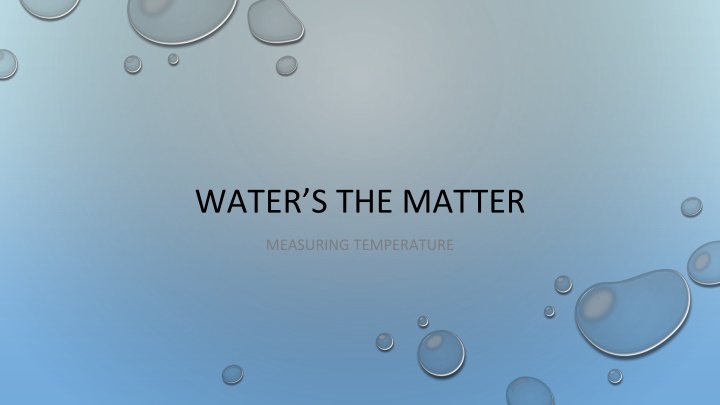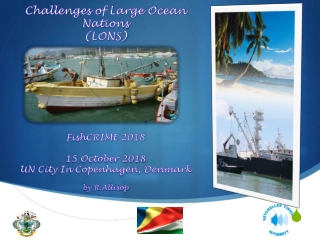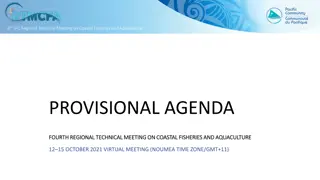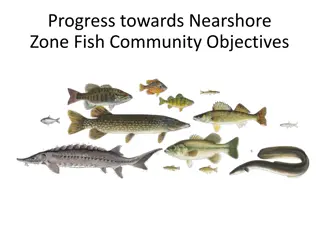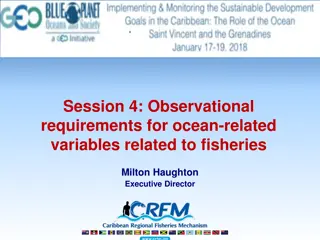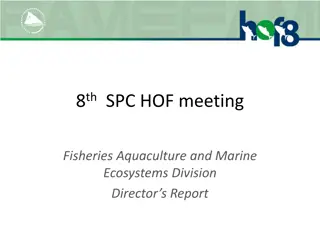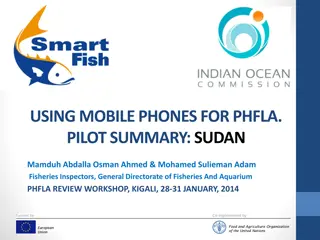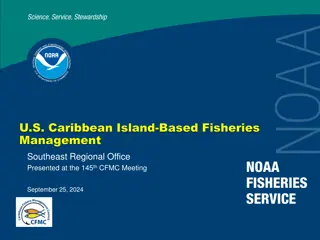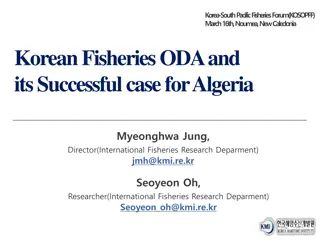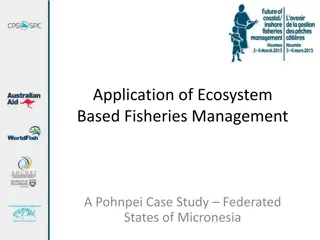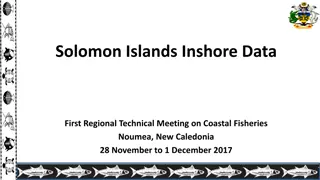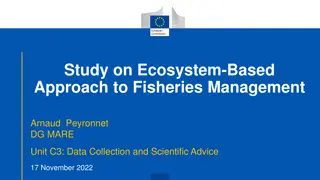Nearshore Fisheries Development Section Highlights & Plans for 2013
The Nearshore Fisheries Development Section emphasizes sustainable nearshore fisheries to enhance food security, livelihoods, economic growth, and climate change adaptation in PICTs. The section comprises professional staff supporting fishing technology, seafood export facilitation, fishermen's associations, and fisheries economics. Ongoing partnerships with various organizations aim to enhance fisheries development. Key inputs in fishing technology include exploratory projects, FAD work, and training initiatives in different regions. The section's 2013 plans include FAD projects with data collection, fisheries diversification projects, sport-fishing tourism development, and educational initiatives across various locations.
Download Presentation

Please find below an Image/Link to download the presentation.
The content on the website is provided AS IS for your information and personal use only. It may not be sold, licensed, or shared on other websites without obtaining consent from the author.If you encounter any issues during the download, it is possible that the publisher has removed the file from their server.
You are allowed to download the files provided on this website for personal or commercial use, subject to the condition that they are used lawfully. All files are the property of their respective owners.
The content on the website is provided AS IS for your information and personal use only. It may not be sold, licensed, or shared on other websites without obtaining consent from the author.
E N D
Presentation Transcript
WATERS THE MATTER MEASURING TEMPERATURE
NAVIGATION TABLE Water s the Matter: Measuring Temperature Introduction Pre-Test Lesson Activity Self Study Game Post-Test
Measuring Temperature Introduction Introduction
Introduction Measuring Temperature HOW IMPORTANT IS WATER TEMPERATURE? Imagine that you were getting ready to jump into a swimming pool. Would you care about the temperature in the water of the swimming pool? Why?
Introduction Measuring Temperature HOW IMPORTANT IS WATER TEMPERATURE? Well, as you can imagine, water temperature is an important factor in determining which organisms can survive in a given watershed or aquatic habitat. So here are a few critical questions for you: Do some organisms prefer cooler water and other organisms prefer warmer water in their habitat? Does water temperature affect the water quality of a river or stream? What happens to organisms when water temperature changes? In this unit we will discuss the concept of how temperature plays a role in water quality.
Measuring Temperature Objectives After completing this module, you will be able to: Recognize how water temperature affects water quality in a watershed. Recognize how water temperature affects the organisms that live in water. Describe the factors (including human effects) that can change the temperature of a body of water. Model the effects of human activity on the temperature of water.
Measuring Temperature Pre- Test Google Assessment
Measuring Temperature Lesson Lesson
Lesson Measuring Temperature Let s go back to our definition of water quality from the first unit. Water quality can be defined as a measure of the suitability of water for a particular use based on selected physical, chemical, and biological characteristics. In the case of temperature, it is a physical property of water that definitely affects the suitability of water for a particular use, like swimming in our example above. Water temperature can be described as how hot or cold water is, but hot and cold are arbitrary terms. We define temperature as a measurement of the average thermal energy of a substance. Temperature is an abiotic (non-living) factor that affects organisms in the environment. In fact, some researchers have labeled temperature as the ecological master factor for its effects on most of the other abiotic factors in an environment.
Lesson Measuring Temperature All organisms have temperature preferences or a range of tolerance. Range of tolerance is a set of environmental conditions within which an organism can best survive and reproduce. These abiotic conditions can include pH, salt level (salinity), oxygen level, and temperature. Every organism can survive and thrive within a certain temperature range. Stonefly nymphs survive best in a range of water temperature from about 44 F to 71 F, which is considered cold or cool. Salmon also survive best within a similar temperature range. In their ecosystem, salmon frequently consume stonefly nymphs. Stonefly nymph-a common food source for aquatic organisms in cool water By B hringer Friedrich - Own work, CC BY-SA 2.5, https://commons.wikimedia.org/w/index.php?curid=2 187465
Lesson Measuring Temperature Dragonfly nymphs and carp fish have a range of tolerance of water temperature that is much warmer- from 63 F to 86 F. In warmer water, carp feed on dragonfly nymphs. Carp fish live in warmer water By Karelj - Own work, Public Domain, https://commons.wikimedia.org/w/index.php?curid=14665758
Lesson Measuring Temperature Perhaps, if you are familiar with fish, you might be able to guess whether bass or trout prefer warmer water conditions. Which of these fish live in warmer waters? Trout Bass The answer is Bass live in warmer water.
Lesson Measuring Temperature Both trout and bass depend on water as their habitat, and they depend on it for food. Bass can be found in warm rivers, lakes, and even stock ponds. Trout require colder streams or lakes to survive and reproduce. Question: Looking at this map of the Rio Grande River (in blue), where do you think trout would most likely live? In the upper Rio Grande in New Mexico, or in the lower Rio Grande in Texas? Answer: Trout would most likely be found in the upper Rio Grande where the water temperatures are cooler.
Lesson Measuring Temperature Organisms other than fish also may have a certain temperature ranges of tolerance. The penguin, even though it is a bird, spends much of its lifetime in the water and is adapted to survive cold water temperatures. Some organisms, known as thermophiles, are able to survive temperatures that reach the boiling point! Many thermophiles are single- celled organisms in the domain Archaea. They are found in hot springs like in Yellowstone National Park and in deep sea hydrothermal vents. Thermophiles produce some of the bright colors of Grand Prismatic Spring, Yellowstone National Park https://commons.wikimedia.org/wiki/File:Grand_prismatic_spri ng.jpg
Lesson Measuring Temperature WATER TEMPERATURE CAN AFFECT WATER AND THE ORGANISMS THAT LIVE IN WATER IN SEVERAL WAYS Water temperature affects: the amount of oxygen that can be dissolved in the water the temperature of the organisms within the water, their activity, rate of growth, and reproduction, the rate of photosynthesis by plants in the water, and the health of organisms in the water.
Lesson Measuring Temperature HOW IS THE TEMPERATURE OF WATER MEASURED Temperature is measured using a variety of tools. Simple thermometers can be used. Digital thermometers are also used by many scientists. Temperature is usually expressed in degrees Fahrenheit or Celsius. A water quality meter that has a digital thermometer accessory. A simple thermometer used to measure water temperature.
Lesson Measuring Temperature HOW IS THE TEMPERATURE OF WATER MEASURED Zero degrees Celsius is equal to 32 degrees Fahrenheit, and 25 degrees Celsius is equal to 77 degrees Fahrenheit. To convert between degrees Fahrenheit to degrees Celsius, the following formulas can be used: Using a digital thermometer to measure water temperature. https://extension.usu.edu/utahwaterwatch/monitoring/field- instructions/temperature/
Lesson Measuring Temperature HOW DOES TEMPERATURE AFFECT THE AMOUNT OF DISSOLVED OXYGEN IN WATER? Dissolved oxygen (DO) is a measure of how much oxygen is dissolved in the water. In other words, DO is the amount of oxygen available to living aquatic organisms. The amount of dissolved oxygen in a stream or lake can tell us a lot about its water quality. Temperature is important because it affects the amount of dissolved oxygen in the water. Dissolved oxygen is important for fish and other organisms that live in the water and require oxygen to live. Water temperature and dissolved oxygen are inversely related to each other. That means that as temperature increases, the amount of dissolved oxygen decreases; and as temperature decreases, the amount of dissolved oxygen increases. Thus, an inverse relationship describes a situation in which a change in one thing (e.g. temperature) causes something else (e.g. dissolved oxygen) to change in the opposite direction. Question: Does cooler water contain more or less dissolved oxygen than warmer water? Image from: https://www.fondriest.com/environmental- measurements/parameters/water- quality/dissolved-oxygen/
Lesson Measuring Temperature HOW DOES TEMPERATURE AFFECT THE AMOUNT OF DISSOLVED OXYGEN IN WATER? Answer: Cooler water contains more dissolved oxygen than warmer water. Certain organisms require a minimum amount of dissolved oxygen in water to survive. If water temperature is increased, the amount of dissolved oxygen will decrease, and some organisms will not be able to survive. There is another unit in this module that further explains dissolved oxygen and how it is measured. For a deeper look at inverse and direct relationships, please see Activity One.
Lesson Measuring Temperature HOW DOES WATER TEMPERATURE AFFECT THE BODY TEMPERATURE OF ORGANISMS WITHIN THE WATER AND THEIR RATE OF GROWTH AND REPRODUCTION? Most animals like fish and amphibians that live in water will have the same temperature within their bodies as the temperature of the water that surrounds them. This is commonly called cold-blooded, but scientifically known as poikilothermic or ectothermic. Aquatic organisms have adapted over time to survive and reproduce best within a range of tolerance of temperatures. Fish are among the most sensitive animals to temperature, with different species needing a certain water temperature range for optimal breeding, feeding and digestion, growth and survival.
Lesson Measuring Temperature HOW DOES WATER TEMPERATURE AFFECT THE BODY TEMPERATURE OF ORGANISMS WITHIN THE WATER AND THEIR RATE OF GROWTH AND REPRODUCTION? As a general rule, as water temperatures rise, the metabolism and activity of aquatic life also rises. That means they are more active in warmer water and they require more food. This rate drops at temperatures over about 100 F, though. In warmer environments fish have a longer growing season and faster growth rate but tend to have a shorter life span than in cool water. As a general rule, fish that live in colder water tend to be larger. A study found that the body size of fish decreases by 20 to 30 percent for every 1-degree Celsius increase in water temperature. Some say that this might mean that as our oceans increase in temperature, the size of fish will decrease. Reproductive systems are very sensitive to temperature and, as a result, organisms tend to reproduce best at a particular time of year. Reproduction of organisms tends to change with the seasons and, therefore, is directly related to the temperature of an organism's environment.
Lesson Measuring Temperature HOW DOES TEMPERATURE AFFECT THE RATE OF PHOTOSYNTHESIS BY AQUATIC PLANTS? Water plants also have a range of tolerance for temperatures. These ranges vary by plant species. But again, as a general rule, as water temperature increases, plants tend to produce more oxygen, to grow faster, and to die at a faster rate. However, they do have an upper limit of temperature, over which, they will not thrive. During the day, plants are producing oxygen and dissolved oxygen levels in the water tend to increase throughout the daylight hours. In the dark, photosynthesis stops, but the consumption of oxygen by organisms continues. Therefore, at night and in early morning hours, the amount of dissolved oxygen in the water tends to decrease. Bacteria in the water feed on dead plants. These bacteria use up some of the dissolved oxygen in the water. Therefore, as more plants die, the amount of dissolved oxygen in water decreases. Algae covers a lake
Lesson Measuring Temperature HOW DOES TEMPERATURE AFFECT THE HEALTH OF ORGANISMS IN THE WATER? Temperature can affect an organism's resistance to disease, parasites, and toxic waste. Water temperatures that are lower or higher than normal can make an organism more sensitive to pollutants and diseases caused by bacteria, viruses, and parasites. Fish and other organisms that are exposed to altered environmental conditions (e.g. temperature or amounts of dissolved oxygen) are referred to as being stressed. When fish and other organisms are stressed they may not be as healthy or live as long. Icy water + waste water discharge = stressful conditions
Lesson Measuring Temperature WHAT FACTORS CAN CHANGE THE TEMPERATURE OF A BODY OF WATER? There are many factors that can change the temperature of a body of water. Key among those are: 1. air temperature 2. sunlight 3. turbidity or the amount of solids suspended in the water (like soil) 4. thermal pollution An increase in any of these factors will increase water temperature.
Lesson Measuring AIR TEMPERATURE AND SUNLIGHT Temperature The greatest source of heat transfer to water is from sunlight. Sunlight, or solar radiation, is a form of thermal energy. This energy is transferred to a water s surface as heat, increasing the temperature of the water. Water temperatures may change during the day; heating during the daylight hours when the sunlight is heating the water and cooling at night when the sun is not shining. The appearance of steam over a pond on a cold morning is evidence that the pond is transferring heat to the air above it. Air temperature can also affect water temperature, and vice versa. When the air is cold, warm water will transfer energy to the air and cool off. You can see this conduction as fog above the water, or the appearance that the water is steaming. If the air is hot, colder water will receive the heat energy and warm up. Because sunlight and air temperatures affect water temperatures, water temperatures also change as seasonal temperature changes occur.
Lesson Measuring TURBIDITY Temperature Turbidity is the measure of the relative clarity of a liquid. Turbidity is a measurement of the amount of suspended solids in water. The more solids water has in it, the less clear it is. Another way to say this is that it is more turbid. Water may contain materials from soil like silt and clay. It can also contain very tiny particles of inorganic and organic matter, algae, plankton, and other microscopic organisms. Turbidity does affect water temperature. The suspended particles absorb heat from solar radiation more efficiently the water itself. The heat from the suspended particles then is transferred to the water. This increases the temperature of the water. In addition to increasing water temperature, high concentrations of particles can affect light penetration in the water, ecological productivity, and the recreational value of the water (people do not want to swim in water that appears cloudy or dirty). Particles in water can also provide a place where pollutants, especially metals and bacteria, can attach and stay in the water. For humans, drinking water that is cloudy is not appealing, and it may also be a concern to human health. If the particles are not removed, disease causing agents may cause sicknesses in the people who drink the water. Most water treatment facilities around the world are effective in removing turbidity from the water, but there are still cases of human sicknesses caused by polluted water. Turbidity is measured in Nephelometric Turbidity Units (NTU). These bottles show various turbidity levels.
Lesson Measuring THERMAL POLLUTION Temperature Humans can have the greatest effect on water temperature by contributing to thermal pollution. A broad definition of thermal pollution is the degradation of water quality by any process that changes the ambient or natural water temperature. Thermal pollution can result from warm water being discharged from an electric power generating station. In these situations, water is used to cool the powerplant. The resulting water becomes heated and when it is discharged into the environment, it can change the temperature of the body of water it is discharged into. It is said that 75-82 percent of thermal pollution is generated by power plants. The Brayton Point Power Station in Massachusetts discharged heated water to Mount Hope Bay. The plant was shut down in June 2017.
Lesson Measuring THERMAL POLLUTION Temperature Urban runoff of rainwater draining off heated streets, sidewalks, and parking lots can also cause thermal pollution. When rain falls, it soaks into the ground and is absorbed by soil and plants. Some of it even reaches the underground water table (where much of our drinking water comes from). When parking lots and buildings prevent the water from soaking into the soil, the water has no choice but to run off (this is where we get the term runoff) into the nearest body of water. Sidewalks and parking lots are generally much warmer than earth, so the water can be heated. Sewage and other wastewater discharge may or may not be hazardous, but it can change the temperature of surface water. Large quantities of heated wastewater can markedly change the temperature in a river or stream.
Lesson Measuring THERMAL POLLUTION: DAMS Temperature Water is also warmed when a river is dammed. Dams slow the current of rivers and allow the water to be exposed to the sun more than if it were free flowing. This can result in an increased temperature of the entire river. More dams = more thermal pollution Conversely, when water is released from dams for irrigation or water needs in the summer, when river temperatures are naturally high, water cooling can take place. If the water is released from a low point in the dam wall, the coolest water behind the dam is what is released. This water can be more than 50 F (10 C) cooler than the water in the receiving body. Cold-water pollution can cause organisms to disrupt their normal growth, breeding, and habits. As we have seen before, cold temperatures can be deadly for some water organisms.
Lesson Measuring HOW DO WETLANDS AFFECT WATER QUALITY? Temperature Wetlands are direct connections between rivers and the cooler groundwater. The wetlands absorb water which may become part of the groundwater. During floods, they can absorb excess floodwater. Wetlands are also a filter for pathogens, metals, and pollutants. Wetlands delay hazardous chemicals and contaminants from entering the main river all at once. Because of this, wetlands serve to dilute toxic chemicals and allow the slow release of these chemicals into the main water supply. In addition, wetlands increase the amount of dissolved oxygen in the water by filtering out bacteria. Remember that some bacteria consume oxygen. Therefore, water with fewer bacteria will tend to have more dissolved oxygen. Wetlands = natural water filters For more detailed information on wetlands, click here or here.
Measuring Temperature Activity Activity
Activity Measuring Temperature Activity One- Understanding Relationships in Graphing Activity Two- Goldfish/Cold Fish
Measuring Temperature Self Study Game Self Study Game
Self Study Game Measuring Temperature Quizizz Self-Study Game
Measuring Temperature Post- Test Google Assessment
